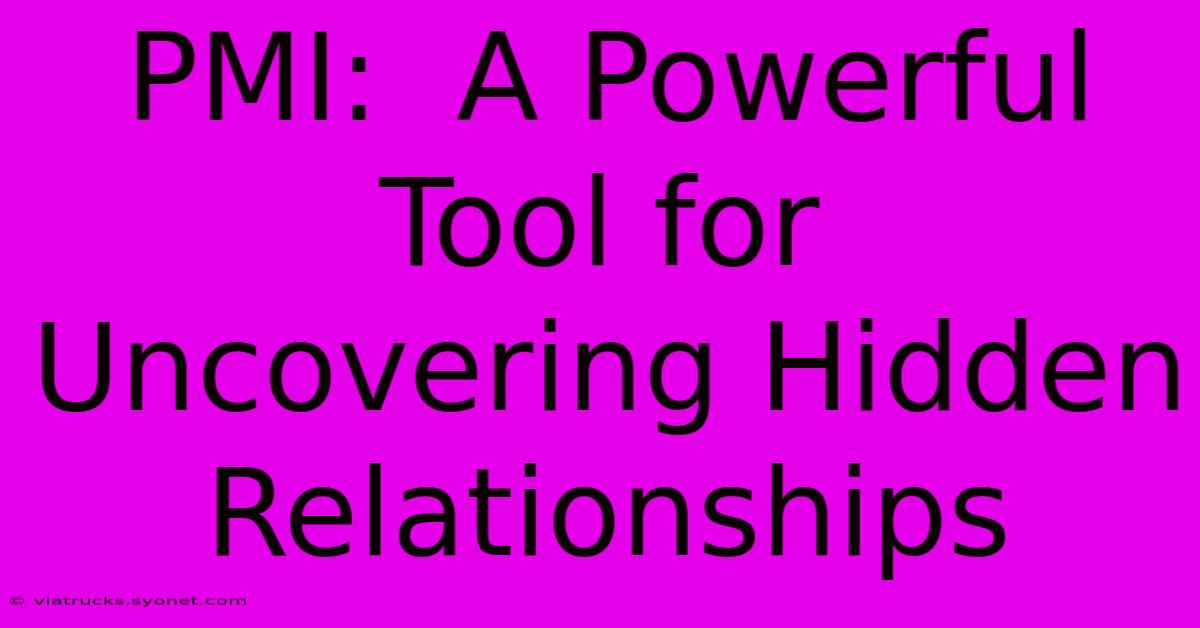PMI: A Powerful Tool For Uncovering Hidden Relationships

Table of Contents
PMI: A Powerful Tool for Uncovering Hidden Relationships
In today's complex world, understanding the relationships between different factors is crucial for effective decision-making. Whether you're analyzing market trends, managing projects, or brainstorming creative solutions, the ability to identify hidden connections can provide a significant competitive edge. This is where the Plus, Minus, Interesting (PMI) technique shines. This simple yet powerful tool helps you uncover unexpected relationships and gain a deeper understanding of any situation.
What is PMI?
PMI is a brainstorming technique used to explore the potential implications of an idea, plan, or decision. It involves systematically listing the plus points (advantages), minus points (disadvantages), and interesting points (uncertain or unexpected aspects) of a particular subject. By separating these three perspectives, PMI facilitates a more balanced and comprehensive assessment, revealing hidden relationships that might otherwise be overlooked.
The Power of Three Perspectives:
- Plus (+): This column focuses on the benefits, advantages, and positive outcomes associated with the subject. What are the potential gains? What works well? What opportunities does it present?
- Minus (-): This section highlights the drawbacks, disadvantages, risks, and potential problems. What are the challenges? What could go wrong? What are the potential downsides?
- Interesting (I): This is where you capture the unexpected, intriguing, or uncertain aspects. These are points that don't easily fit into the plus or minus categories. They may represent unknown variables, potential surprises, or intriguing possibilities worthy of further investigation. This is often where hidden relationships are revealed.
How to Use PMI Effectively:
Applying the PMI technique is straightforward, but its effectiveness depends on a systematic approach:
-
Define Your Subject: Clearly articulate the idea, plan, or decision you're analyzing. Be specific. The more precise your subject, the more insightful your PMI analysis will be.
-
Brainstorm Independently: Initially, work alone to generate ideas for each column (+, -, I). This encourages free-flowing thought and prevents groupthink.
-
Collaborate and Discuss: After completing your individual brainstorming, share your findings with a team. Discuss and add to each column. This collaborative phase often uncovers new insights and strengthens the analysis.
-
Prioritize and Analyze: Once you have a comprehensive list, analyze the information. Prioritize the pluses and minuses. The interesting points often suggest areas needing further research or investigation, uncovering hidden relationships.
-
Action Planning: Based on your PMI analysis, develop a plan of action. How will you leverage the plus points? How will you mitigate the minuses? What further investigation is needed to better understand the interesting points?
Examples of PMI in Action:
Let's illustrate PMI with two examples:
Example 1: Launching a New Product
Subject: Launching a new smartphone with advanced AI features.
| Plus (+) | Minus (-) | Interesting (I) |
|---|---|---|
| Increased market share | High development costs | Potential for unexpected technical challenges |
| Improved brand reputation | Intense competition | Consumer response to AI features: unknown |
| Potential for high profit margins | Risk of product failure | Impact on existing product line: needs assessment |
| Enhanced customer loyalty | Difficulty in scaling production | Integration with other smart devices: compatibility? |
Example 2: Implementing a New Company Policy
Subject: Implementing a new flexible work policy.
| Plus (+) | Minus (-) | Interesting (I) |
|---|---|---|
| Increased employee satisfaction | Potential for communication challenges | Impact on team cohesion: long-term observation needed |
| Improved work-life balance | Difficulties in managing remote teams | Change in office space utilization: reassessment |
| Reduced office overhead costs | Potential for decreased productivity (initially) | Employee preference changes over time: monitor |
| Attracting top talent | Increased IT infrastructure requirements | Unforeseen legal implications: compliance check |
Uncovering Hidden Relationships with PMI:
The "Interesting" column is where the real power of PMI lies. By highlighting the unknown and unexpected, it forces you to consider possibilities that might otherwise be overlooked. These unexpected insights often reveal hidden relationships between factors that weren’t immediately apparent. For instance, in the flexible work policy example, the interesting points highlight the need for long-term observation of the impact on team cohesion, raising a hidden relationship between flexibility and teamwork.
By consistently using PMI, you'll sharpen your analytical skills, improve your decision-making, and uncover valuable hidden relationships in all aspects of your personal and professional life. It's a simple, yet profoundly effective tool for navigating complexity and achieving success.

Thank you for visiting our website wich cover about PMI: A Powerful Tool For Uncovering Hidden Relationships. We hope the information provided has been useful to you. Feel free to contact us if you have any questions or need further assistance. See you next time and dont miss to bookmark.
Featured Posts
-
Whats App Messages Gwynne Loses Post
Feb 09, 2025
-
Unlocking Victory Analyzing Barca And Monaco Starting Xis
Feb 09, 2025
-
Discover Felipe Angeles Mexico Citys Best Kept Secret
Feb 09, 2025
-
The Ultimate Guide To Love Island All Stars
Feb 09, 2025
-
Mastering Editorials Your Guide To Informed Opinions
Feb 09, 2025
